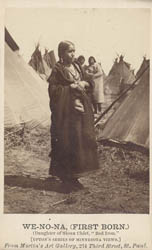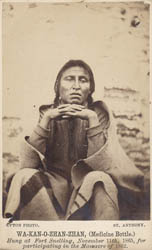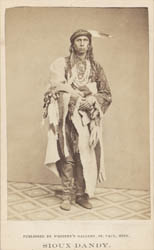Photographing the American Indian:
Portraits of Native Americans, 1860-1913, from the collections of
the Massachusetts Historical Society
Photographing the Sioux Indians
These photographs were collected by historian Francis Parkman and depict the Sioux Indians, in whom Americans held a particular interest during the early 1860s. In August of 1862, the Dakota (one group of the Sioux who occupied what is now the state of Minnesota) began an armed uprising along the southwestern border of the Minnesota Territory, eventually killing hundreds of whites. The 1862 conflict marked the beginning of an ongoing confrontation between the Sioux and the United States that would last until the battle at Wounded Knee in South Dakota on 29 December 1890, when more than 300 Sioux were killed by United States soldiers.
Most of these carte de visite portraits depict Sioux men and women shortly after the 1862 uprising. Some of the images were taken at Fort Snelling, where displaced members of the tribe were encamped before the United States Congress called for the forcible removal of all Sioux from Minnesota in April of 1863. It is likely that the photographs of We-no-na (Daughter of Sioux Chief "Red Iron") and the Tepees of the Sioux Indians were taken in the encampment area connected with Fort Snelling. The photographs of Wo-Wi-Na-Pe (Little Crow's Son), taken in 1864, and Wa-kan-o-zhan-zhan (Medicine Bottle), taken between 1864 and 1865, depict two individuals who were held by the military as prisoners and put on trial for their actions in the uprising.
The images reveal the conflicted place that the Sioux occupied in the American mind. The native subjects are variously portrayed by the photographer as noble victims of American oppression, as curiosities to be visually cataloged before their eventual extinction, or as savages, object-lessons to justify to the American public the government’s actions against the Sioux. The captions listed with each photograph were either published by the photographer or written in pencil by the collector or an associate; these captions provide insight into the intention of the photographer toward his Sioux subjects as well as the ways in which the images were further interpreted by those who bought them.
About the Photographers
Most of the photographs of the Minnesota Sioux in this exhibition were taken by Benjamin Franklin Upton (b.1818), originally of Maine. Upton made his living as a photographer in St. Anthony, Minnesota from circa 1855 through the 1880s. Many of his original negatives are held by the Minnesota Historical Society.
Other photographs in this series were taken by Joel Emmons Whitney (1822-1886) of Whitney's Gallery in St. Paul, Minnesota, who photographed from 1851 to 1871. Also born in Maine, Whitney was the first photographer in St. Paul, Minnesota, and began working first with daguerreotypes and then as a wet plate photographer. During the early years of the Civil War, Whitney photographed many Minnesota volunteers and also sold cartes de visite of Minnesota Indians. After the Sioux uprising, there was great public demand for photographs of the principal participants and Whitney made available many of his images of the Dakota as well as of the soldiers who suppressed the uprising. He is considered one of the most eminent early photographers in the United States. He additionally worked as a merchant, miller, and a banker.
About the Collector
The portraits exhibited here were collected by the historian Francis Parkman. Parkman, a graduate of Harvard College, Class of 1844, had studied Plains Indian life while travelling and hunting with the Sioux along the Oregon Trail in 1846. He was a diligent and prolific historian. In addition to writing The Oregon Trail: Sketches of Prairie and Rocky Mountain Life, he wrote France and England in North America, a multi-volume epic including the titles, The Conspiracy of Pontiac and the Indian War After the Conquest of Canada, and Jesuits in North American in the Seventeenth Century, in which American Indians play a central role. The photographs he collected were taken circa 1860-1871 and depict Pawnee, Ottawa, Arapaho, Ute, Cheyenne, and Sioux natives.
********** DO NOT EDIT THIS LINE OR BELOW*************









